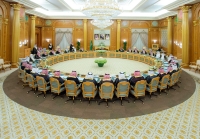
The Shemagh and Ghutra are traditional men's head coverings in the Kingdom of Saudi Arabia. They are an essential part of Saudi attire, which is known for its diverse styles of wearing them more than others. The Shemagh or Ghutra is worn with the Saudi thobe and the black Agal . The difference between the Shemagh and Ghutra lies in their design. The Shemagh is characterized by square patterns embroidered in red and has become the most common head covering in the Kingdom since the mid-1970s...

Traditional Female Garments in the Kingdom of Saudi Arabia refer to the garments that emerged as a result of customs and traditions in Saudi women's dress. Over time, it has evolved and diversified with cultural shifts according to women's preferences for local and global fashion. Traditional garments are considered a national heritage identity closely tied to the customs of each province in Saudi Arabia. Al-Abaya in traditional female garments in Saudi Arabia Al-Abaya is a garment th...

Ma'amool ad-Dawasir is a type of blended perfume crafted and manufactured in the Kingdom of Saudi Arabia. It falls under a diverse category of mixed Bakhoor (incense). It is primarily used to scent homes, serving as an air freshener. It is prepared by women, and sometimes by men specialized in perfumery. Ingredients of Ma'amool ad-Dawasir Ma’amool ad-Dawasir is composed of finely ground oud, selected based on the quality of the desired product. Sometimes, a lower-quality residue of ...

The official attire for men in the Kingdom of Saudi Arabia is uniform across all provinces. It consists of a thobe , which comes in various types and colors, and a head covering—either a Ghutrah or a Shemagh , topped with Al-Egal . Officials typically wear the Bisht (cloak) most of the time, while ordinary individuals wear the Bisht on formal occasions and during holidays. The term Saudi national attire is used to describe three main components: the Thobe, Shemagh, and Al-Egal. Some part...

Henna is a dye prepared from the henna tree (Lawsonia inermis, Lythraceae). The color of henna powder differs from its stained color on the skin. In the Kingdom of Saudi Arabia, the term 'henna' also refers to the art of intricate designs applied to the hands and feet, a tradition associated with wedding ceremonies in certain provinces of Saudi Arabia. Once the henna color transitions from dark red to golden yellow, it remains for a few days before gradually fading through peeling, ty...

Al-Subha or Al-Misbaha (Prayer Beads) is one of the traditional handicraft products in the Kingdom of Saudi Arabia . Its craftsmanship has been passed down through craftsmen across various provinces of Saudi Arabia , gaining such popularity that it became an integral part of Saudi cultural identity. Making of Al-Subha historically Making Al-Subha dates back around five thousand years to the Sumerians. It was also known in several other civilizations, including the Pharaonic, Indian, and Persia...

Al-Mishlah al-Hassawi or al-Ahsa'i (al-Ahsa Cloak) is the most expensive type of cloak in the Kingdom of Saudi Arabia. Its high price is due to the quality of its materials, the skills of its maker, and its ornamentation with golden zari imported from Germany, France, or India. The process of weaving the Mishlah goes through seven stages, starting with al-Tarkeeb, al-Tawq, al-Haila, al-Buruj, al-Maqsar, al-Qitan and al-Khabana, and finally, the stage of al-Bardakh in which the zari is embr...

Traditional attire in the Kingdom of Saudi Arabia is closely tied to the customs and traditions of both men and women. Each of the Kingdom's thirteen provinces has its own fashion heritage, distinguished by its unique stitching, ornamentation, and style, which have become integral to its identity. The traditional formal attire for men in the Kingdom is the Saudi Thobe , which serves as the main component of the official Saudi dress. Women's clothing, however, differs from men's i...

Garments of al-Madinah al-Munawwarah Province are apparel that reflect the popular heritage in the clothing of men and women in al-Madinah al-Munawwarah Province of the Kingdom of Saudi Arabia . In the past, garments differed from one person to another, based on the person's financial and social status. Hence, some garments were expensive, while others were affordable. In general, these traditional garments were the most notable within the heritage context. Traditional men's garments ...

Traditional attire for both men and women in the Eastern Province of the Kingdom of Saudi Arabia has varied over time. Some featured simple designs and materials, while others were ornate and worn for special occasions and festivals. Additionally, there were specific garments designated for work. Traditional attire in the Eastern Province includes: Men’s attire • Izar : A piece of cloth wrapped around the lower body twice. It is typically worn at home or for sleeping, and is commonly used d...

In the Kingdom of Saudi Arabia , the dress code for attendees at official events is often specified on invitation cards, which typically require wearing the national Saudi attire. If the Custodian of the Two Holy Mosques or the Crown Prince is attending the event, the color of the Mishlah (cloak) for the guests is also specified. Anyone wearing the Mishlah must follow specific protocols, including refraining from crossing one leg over the other or extending the legs while seated. The right hand...

Al-Janbiya, also known as the dagger, is named so because it is affixed to the right or left side of a man's body using a belt made of fabric or leather that is tightly tied around the waist. This is the most common appearance, but it can also be affixed in the middle of the body. Al-Janbiya is considered one of the cultural symbols of the south of the Kingdom of Saudi Arabia and is part of the traditional costumes. It is worn during folkloric dances, social events, and holidays. The trad...